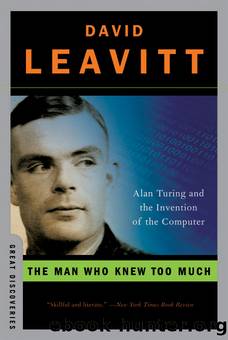The Man Who Knew Too Much by David Leavitt

Author:David Leavitt
Language: eng
Format: epub
Publisher: W. W. Norton & Company
The Enigma Machine, employed by the Germans to encrypt classified and sensitive messages during World War II. (HultonArchive/Getty Images)
Inside each rotor a mass of wires connected the contact points on the right face to those on the left. This wiring, though arbitrary, was fixed; that is to say, even though the rotors could be placed in different orders, all the rotors in all the Enigma machines in the system were wired alike. This insured that rotor 1 on the senderâs Enigma would have wiring identical to that of rotor 1 on the recipientâs Enigma. And since the rotor order was one of the elements fixed in advance, there was no chance of cross-wiring.
A series of switches connected the rightmost of the rotors to the keyboard. In the commercial Enigma, the letters on the keyboard were linked up with the contact points on the first rotor in the same order as that found on the keyboard; in the military Enigma, however, the wiring had been changed, and one of the first challenges the code breakers faced was to figure out what the new order was. Because the top row of letters on a German typewriter reads QWERTZUIO (as opposed to the QWERTYUIOP found on American typewriters), Dilwyn Knox, one of the first Englishmen to take on the Enigma, referred to the mysterious new letter order as the âqwertzu.â Though Knox feared that this order might prove so arbitrary as to defy analysis, to his great surprise, a group of Polish cryptanalysts led by Marian Rejewski quickly determined that in the military model of the Enigma, the Germans had simply connected the letters on the keyboard to the contact points on the first rotor in alphabetical order. This was the first of several instances in which German laziness and lack of imagination ended up aiding the code breakers in their effort to defeat the machine.
When a letter was typed into the Enigma, current flowed from the keyboard into the rightmost rotor, which then shifted one position, thus changing the letterâs identity. The current continued through the other two rotors, with a substitution occurring in each position. Next the current entered a âreflector,â a half-width disk at the left end of the machine with contacts only on its right side. The reflector connected pairs of letters, replacing the incoming letter with a second one, which would then be sent back through the three rotors for another series of substitutions. Its function was to guarantee that no letter typed into the Enigma could be enciphered as itself; it was also responsible for the Enigmaâs property of being able to serve as both an encipherment and a decipherment machine.
A last elementâincorporated into the military Enigmasâwas a âsteckerâ board, rather resembling an old-fashioned telephone switchboard and located at the base of the machine, with twenty-six jacks (or âsteckersâ) into which cables could be plugged. On these machines the positions of the steckers also had to be agreed upon in advance. Steckered pairs of letters would be
Download
This site does not store any files on its server. We only index and link to content provided by other sites. Please contact the content providers to delete copyright contents if any and email us, we'll remove relevant links or contents immediately.
Mastering Bitcoin: Programming the Open Blockchain by Andreas M. Antonopoulos(2525)
Dawn of the New Everything by Jaron Lanier(2446)
Blockchain: Ultimate Step By Step Guide To Understanding Blockchain Technology, Bitcoin Creation, and the future of Money (Novice to Expert) by Keizer Söze(2145)
Alibaba by Duncan Clark(1760)
Owning Bitcoin: The Illustrated Guide to Security, Privacy, and Potential by Apodaca Richard(1722)
Foundations of Blockchain by Koshik Raj(1658)
Significant Zero by Walt Williams(1637)
The Mastermind by Evan Ratliff(1602)
Bitcoin: The Basics of Blockchain and Investing in Cryptocurrency by K. Connors(1567)
Mastering Blockchain by Imran Bashir(1442)
Attack of the 50 Foot Blockchain by David Gerard(1434)
Bitcoin: The Ultimate Guide to the World of Bitcoin, Bitcoin Mining, Bitcoin Investing, Blockchain Technology, Cryptocurrency (2nd Edition) by Ikuya Takashima(1426)
The Bitcoin Standard: The Decentralized Alternative to Central Banking by Saifedean Ammous(1426)
Shaping the Fourth Industrial Revolution by Klaus Schwab & Nicholas Davis & Satya Nadella(1362)
Dawn of the New Everything: Encounters with Reality and Virtual Reality by Jaron Lanier(1339)
Turing's Cathedral by George Dyson(1331)
Cryptocurrency by Neil Hoffman(1330)
The Bitcoin Guidebook by Ian DeMartino(1296)
Bill Gates by Michael Becraft(1268)
